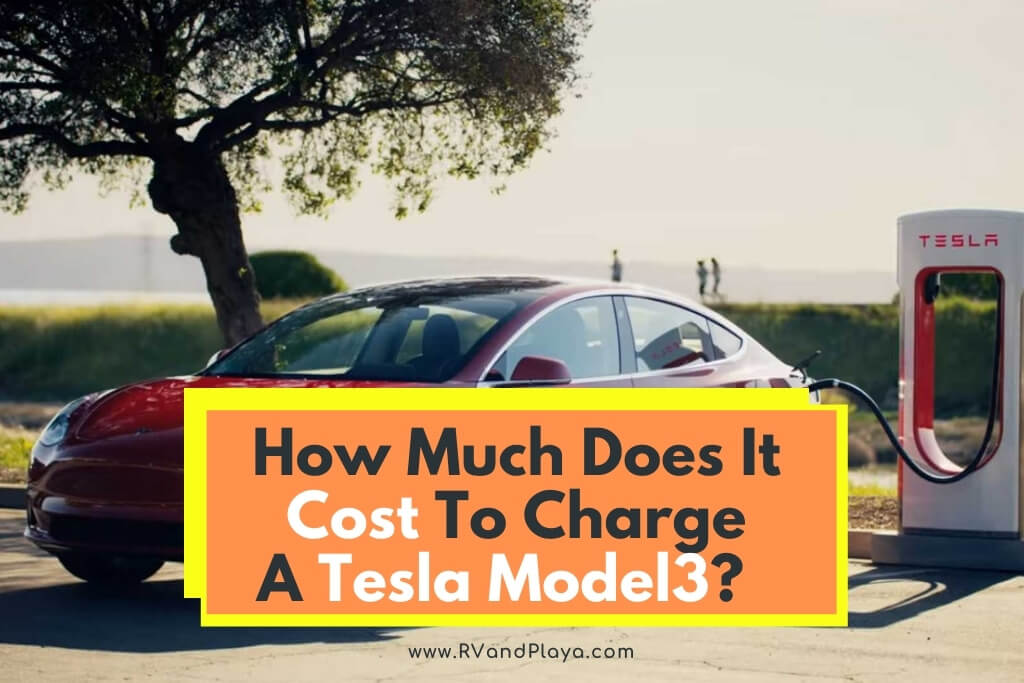Have you ever wondered how much does it cost to charge a Tesla Model 3? Look no more. We´ve got you covered.
There are a few different ways to charge a Tesla, regardless of which model and trim you’re dealing with. Tesla has four models with a total of nine trims amongst them.
Each one costs an average amount according to battery size, weight, features, and aerodynamics.
So, how much does it cost to charge a Tesla Model 3? It costs roughly $8.25 to charge a standard Tesla 3 from 0% to 100%. The Long-Range version of the Tesla 3 ups the ante to $13.41, while the Tesla 3 Performance trim will set you back $13.55 per charge. However, the cost to charge a Tesla per month in the US is around $50.
Tesla is the gold standard in electric vehicle manufacturing, innovation, and marketing. They build an excellent electric vehicle and have released some trims that are more within the range of middle-class America.
As they continue to innovate and release new models, their range and capabilities are bound to improve an already great platform.
The biggest questions surrounding the platform are always, how does it charge your Tesla and how much does it cost?
Table of Contents
How Much Does It Cost To Supercharge A Tesla Model 3?
Supercharging costs are a little higher than traditional charging in your own home. The reason behind this is the extra installation costs, maintenance costs, and fees that Tesla has to fork over to the local electrical companies.
Unfortunately, business is business and those extra costs get passed over to the customer. On the bright side, it’s still a lot cheaper than filling up a gas tank from empty.
- Tesla Model 3 Standard Range Plus: $11.47 per charge with a 50kwh battery
- Tesla Model 3 Long-Range: $18.82 per charge with an 82kwh battery
- Tesla Model 3 Performance: $18.82 per charge with an 82kwh battery
For the Tesla Model 3 Standard Range Plus, that comes out to $0.044 per mile while the Performance and Long-Range Model 3s average $0.060 per mile and $0.053 per mile respectively.
Read also: Tesla Statistics: 75+ Incredible Facts, and Trends To Consider (Explained)
How Much Does It Cost To Charge a Tesla Per Month
The U.S. Department of Transportation’s Federal Highway Administration states the average person drives around 13,500 miles every year. So, 1125 miles every month and a cost of $0.044 per mile.
So, how much does it cost to charge a Tesla per month? On average, the cost to charge a Tesla per month in the US is around $50.
Based on Tesla charging price data, the high end of the EV charging spectrum is around $70 a month in Hawaii. While the low end of spectrum is around $31 a month in Washington state.
| Cost per Mile (USD) | Cost Per Month (USD) | Cost Per Year (USD) | |
|---|---|---|---|
| Cost to Charge a Tesla | 0,0045 | 50 | 600 |
How Long Does It Take To Charge A Tesla Model 3?
A lot depends on what trim you’re charging but the average amount of time it takes to charge a Tesla Model 3 at a supercharger falls between 70 and 75 minutes. However, it only takes 25 minutes to get enough charge for roughly 150 miles of range.
Standard charging service areas—such as those you might find at a hotel or other businesses that have partnered with Tesla—called ChargePoints, will give you about 30 miles of range for every hour of charge.
When charging from home, assuming your battery is dead as a doornail, it will take all night to get a full charge.
That’s why it’s a good idea to plug in as soon as you get home in the evening, so you’re ready to go first thing in the morning with a full battery.
Regardless of what kind of charger you use, the charging percentage increase will mostly be the same, even though the Tesla Model 3 trims have two different batteries.
The 82kW simply holds more juice than the 50kW.
How Do You Charge A Tesla Model 3?
According to Tesla, there are four different methods for charging.
- Wall connector for at-home charging: Order online and a Tesla Technician will have to install it for you
- Mobile Connecter and Adapter: This is the standard charging unit that comes with your Tesla
- Tesla Supercharger: These are spread across the country, installed at select service stations, and are the quickest way to charge your Tesla
- Destination Charging: Called ChargePoint, these are places associated with hotels, gas stations, and other businesses where you can freely plug your Tesla in for charging
Teslas charge in much the same way as you put gasoline in your car, with the charging port usually located next to the driver’s side, rear tail light, quarter panel.
Where Are Tesla Charging Stations Located?
There are 1,200 Tesla charging stations located throughout the U.S. They’re pretty spread out, with the largest concentration of stations located around major metropolitan areas.
Tesla claims that there are enough Tesla stations across the country to ensure you can drive anywhere along a major U.S. interstate and not run out of charge between charging stations.
Meanwhile, Tesla is intensely focused on adding more and more stations across the U.S. As of May, this year, there are 25,000 Tesla supercharger stations across the world, with the goal of adding thousands more as quickly as possible.
Elon Musk also announced that those charging stations would be upgraded—by the end of this year—to accommodate other electric vehicles.
Also, Tesla released a map projecting new, upcoming supercharger stations across the country and the world.
Tesla is clearly devoted to expanding its network while including other brands of electric vehicles as well.
Read also: 45+ Tesla Cybertruck Statistics, Design, Features, Specs, Range
How Many KWH To Charge A Tesla Model 3?
The minimum sized battery in all Tesla models is the 50kWh battery found in the Tesla Model 3 Standard Range Plus. To charge this battery—or any battery with a larger size—the charger must be capable of charging up to 50kWh.
Now, Tesla no longer releases the size of its batteries, and it’s also well-known that built-in safety measures keep the battery from charging to its full, 100% capacity. So, as it currently stands, there must be at least 50kWh to charge a Tesla battery.
That will ensure that even the most minimal Tesla battery will reach its full charge and half of a charge for the 100kWh batteries in the Tesla Model S trims.
The Tesla Model 3 Performance and Long-range trims have 82kWh batteries, so they’ll need a little more, but since the batteries don’t charge to 100%, it’s kind of a guessing game as to how many kW.
How Long Does The Tesla Battery Last?
Tesla applies an eight-year warranty to all of its batteries in all Tesla models. That’s a pretty significant amount of time and it goes to show that Tesla backs their battery engineering prowess.
Of course, that doesn’t mean that Tesla batteries are limited to eight years, just the warranty. According to available data, battery range decreases—due to natural degradation—5% every 50,000 miles.
So, a Tesla Model 3 Long-Range, which has a brand new range of 310 miles will decrease to 294 miles by the time the odometer meets 50,000 miles driven.
Tesla batteries, like many other batteries, especially of similar types, degrade over time and multiple charges. However, that rate of degradation bottoms out after an extended period of time.
In other words, the 5% decrease at the 50,000-mile mark doesn’t equate to a 10% decrease at the 100,000-mile mark. Realistically, you can expect a 10% decrease beyond the 150,000-mile mark.
This means that you can expect a good deal of range and longevity with a Tesla Model 3—or any Tesla model and trim.
Final Word
It really doesn’t cost much to recharge a Tesla Model 3, with the Standard Range Plus being the cheapest of the bunch.
The added expense of stopping at a supercharger station is negligible, as it doesn’t cost much more and is still very cost-efficient when compared to gasoline.
So, you can expect to get plenty of range with the Model 3 trims along with plenty of savings on recharges.
With the eight-year warranty and the considerable longevity built into Tesla vehicles, the long-term savings are significant and lasting.
Here are some of my favorite tools & equipment´s
Thank you for reading this article. I hope it helps you find the most recent and accurate technical and repair information for your car. Here are some tools that I use as an automotive technician and hope you´ll also find helpful.
There are affiliate links, so if you do decide to use any of them, I´ll earn a small commission. But in all honesty, these are the exact tools that I use and recommend to everyone, even my own family. (NO CRAP)
To see all my of most up-to-date recommendations, check out this resource that I made for you!
References
https://www.tesla.com/support/charging
Recent Posts
45+ Tesla Cybertruck Statistics, Design, Features, Specs, Range
Tesla is a leading American EV and clean energy company led by the controversial entrepreneur and businessman Elon Musk. For the last couple of years, Tesla has been putting out electric vehicles...
CyberLandr: 25 Facts About Tesla Cybertruck Pop Up Camper (Explained)
Have you ever wondered what is the Cyberlandr or the new Tesla Cybertruck camper? Well, look no more. We´ve got you covered. The Tesla pop up camper fits the Cybertrucks bed of 6.5ft and is...


